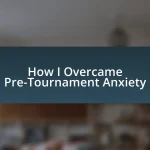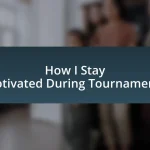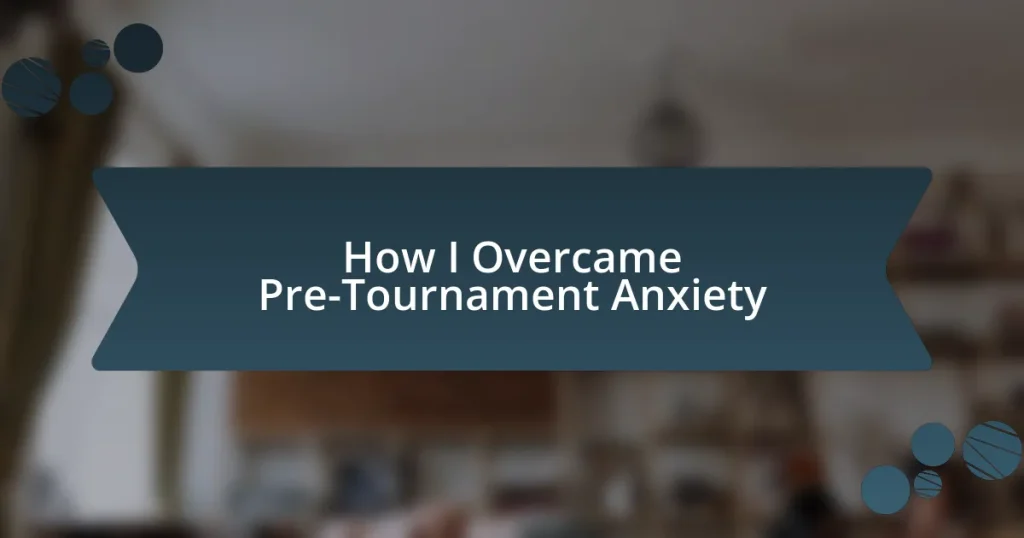Key takeaways:
- Pre-tournament anxiety is common among athletes and can stem from past performances, pressure to perform, fear of judgment, and unexpected circumstances.
- Effective strategies to manage anxiety include visualization, deep breathing, positive self-talk, routine development, and mindfulness practices.
- Developing a consistent pre-tournament routine helps create a familiar environment, reducing anxiety and enhancing focus on performance.
- Breathing exercises, such as the ‘4-7-8’ technique, can significantly calm nerves and improve concentration before competitions.
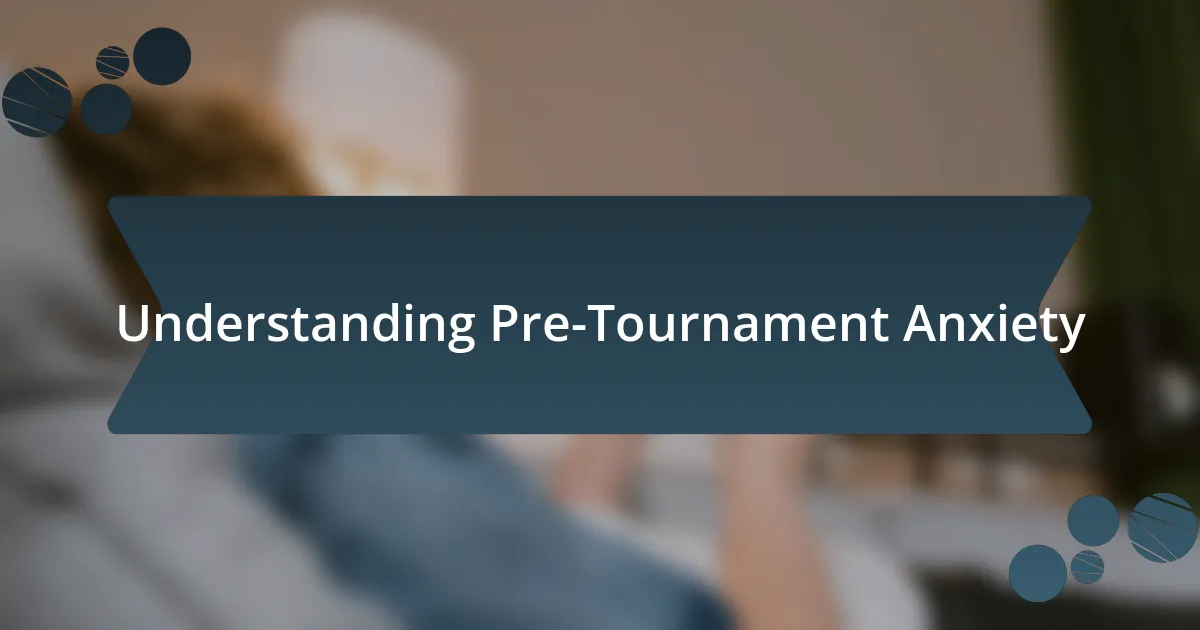
Understanding Pre-Tournament Anxiety
Pre-tournament anxiety is a common hurdle that many athletes face, often manifesting as a mix of excitement and fear. I remember standing at the edge of the court, heart racing and palms clammy, questioning if I was truly ready. What if I let my team down? This internal dialogue can be overwhelming, creating a loop of self-doubt that does little to help performance.
Understanding the roots of this anxiety can be enlightening. For me, it stemmed from past performances where I felt I hadn’t reached my potential. As the tournament day approached, I would replay those moments, wondering if I was up to the challenge. Have you ever felt like the pressure was too much, questioning whether you belong in such competitive settings? Recognizing that these feelings are completely natural is the first step toward managing them.
The emotions tied to pre-tournament anxiety often fluctuate, ranging from anticipation to sheer terror. I recall an instance where I felt a knot in my stomach while warming up, yet, surprisingly, it fueled my determination. It’s interesting to consider—can anxiety actually transform into a motivating force? Understanding this duality can change how we approach our fears, shifting our perspective from dread to a potential source of strength.
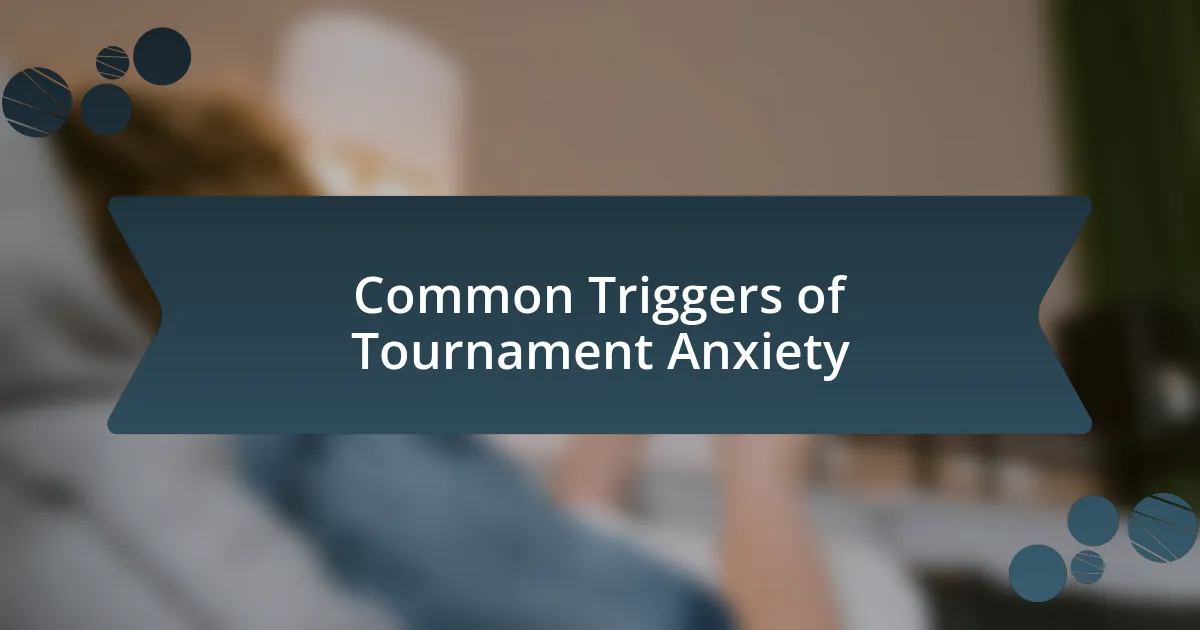
Common Triggers of Tournament Anxiety
Common triggers of tournament anxiety can vary widely among individuals, but certain patterns often emerge. For instance, the pressure to perform can be immense, especially when it feels like the weight of the world rests on your shoulders. I remember feeling a tightening in my chest as I anticipated my performance, worrying about how my results would affect my team’s morale. This kind of pressure is powerful and can easily lead to heightened anxiety.
In addition to performance pressure, fear of judgment from peers and coaches can amplify anxiety levels. I often found myself imagining the critical eyes of those I respected watching every move I made. Would they think I was unprepared? That lingering thought often left me frozen, hesitating to take risks that could lead to success. The anticipation of judgment can distract from what truly matters: enjoying the sport and giving it your all despite the potential critiques.
Lastly, unexpected circumstances can be a significant anxiety trigger. I once faced technical difficulties with my gear right before a big match, and the panicky thoughts spiraled in my mind. What if my equipment failed midway through the tournament? Recognizing that these triggers are common can be the first step in addressing them. Each event can bring a different set of challenges, but knowing I’m not alone in this experience helps me regain my focus.
| Trigger | Description |
|---|---|
| Pressure to Perform | Feeling overwhelmed by expectations can create anxiety. |
| Fear of Judgment | Worrying about others’ perceptions can lead to self-doubt. |
| Unexpected Circumstances | Unforeseen issues can provoke panic and distraction. |
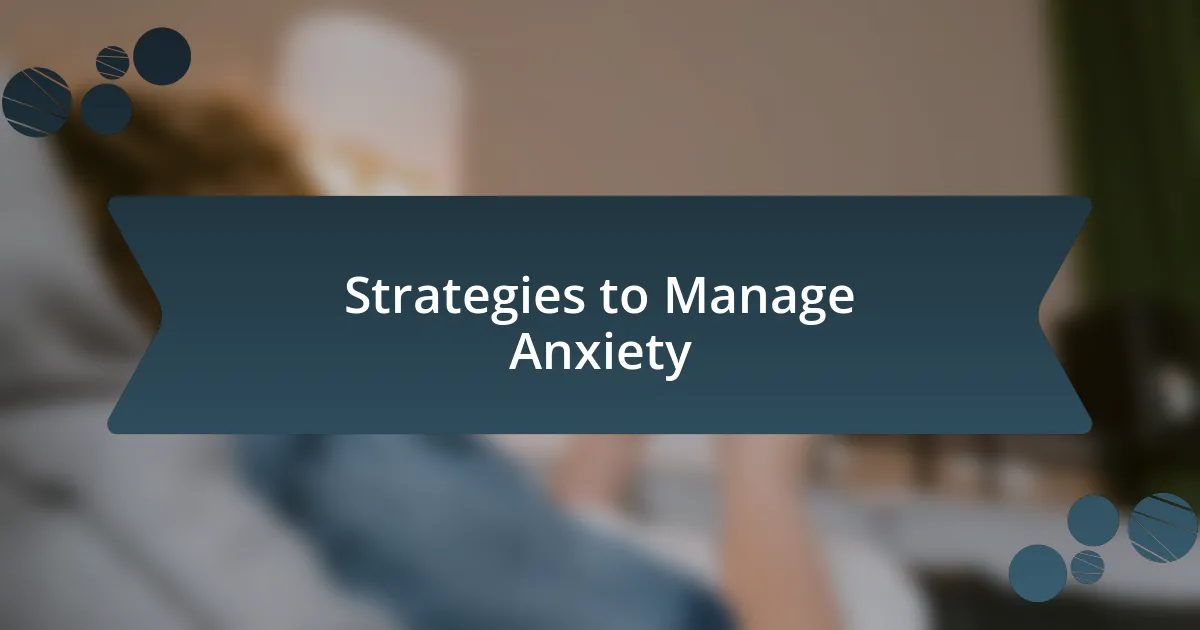
Strategies to Manage Anxiety
Managing anxiety before a tournament requires practical strategies that resonate on a personal level. One technique that worked for me was visualization. Before competitions, I would spend a few moments imagining myself performing confidently. This simple practice transformed my anxious energy into a powerful vision of success. Additionally, grounding techniques helped me stay in the moment. Focusing on my surroundings or practicing deep breathing brought clarity and calm when nerves threatened to overwhelm me.
Here are some effective strategies to manage anxiety:
- Visualization: Imagine yourself succeeding in your performance; this can boost confidence.
- Deep Breathing: Taking deep, controlled breaths can significantly reduce anxiety levels.
- Positive Self-Talk: Replace negative thoughts with affirming statements to uplift your mindset.
- Routine Development: Establishing a pre-tournament routine can create a sense of familiarity and control.
- Mindfulness Practices: Engaging in mindfulness or meditation sessions can enhance your focus and reduce stress.
By incorporating these strategies, I learned to reclaim my mindset before tournaments, allowing me to focus on the joy of competing rather than the anxiety that often crept in.
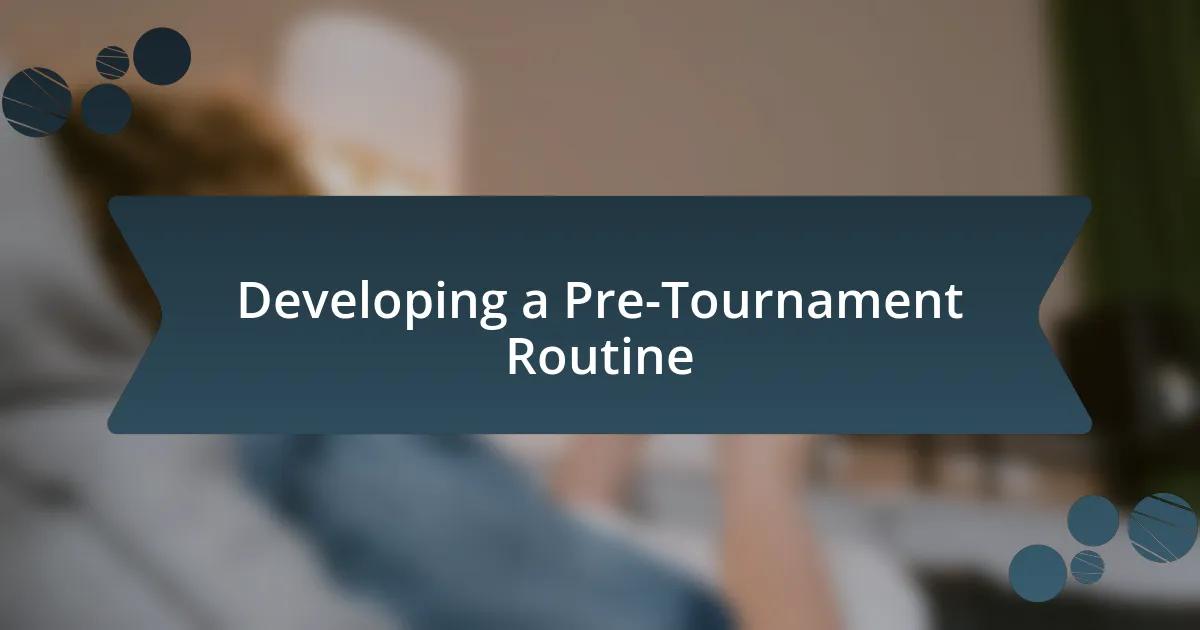
Developing a Pre-Tournament Routine
Creating a pre-tournament routine was a game-changer for me. I remember the first time I implemented a consistent setup before competing; I felt like I was entering a familiar space rather than facing an unpredictable challenge. Picture this: I would lay out all my gear, perform a few stretches, and listen to my favorite playlist. This not only focused my mind but also ignited a spark of excitement instead of dread.
Moreover, I found that incorporating specific rituals really helped anchor my thoughts. For instance, I would always take five minutes before heading to the venue to sit quietly and mentally rehearse my game plan. Have you ever noticed how a small, deliberate act can shift your whole mindset? This moment of intentional focus often transformed any lingering anxiety into a concentrated determination to perform well.
Lastly, timing my routine played a crucial role. I learned to start my pre-tournament activities at the same time before each competition, creating a rhythm that my mind could rely on. I can still feel the calm that washed over me as I engaged in this structured approach, knowing I was preparing not just physically, but also mentally. Developing this routine helped me harness my anxiety and turned it into a source of readily available motivation.

Visualization Techniques for Success
Visualization has played an essential role in my preparation, particularly when I faced pre-tournament anxiety. I often found a quiet spot, closed my eyes, and vividly imagined myself succeeding in key moments of competition. In those moments, I could almost feel the adrenaline and hear the cheers, which often left me wondering: could my mind genuinely influence my physical performance?
One technique I found incredibly effective was mentally rehearsing specific scenarios I might encounter during the tournament. I’d visualize the pressure, the noise of the audience, and the crucial decisions I had to make. Each time I visualized overcoming these challenges, I felt more equipped in real life, as if I had already run the race a hundred times.
Additionally, I’ve learned to incorporate detailed visualizations into my routine, right alongside my physical prep. For example, after warming up, I would take a few minutes to picture myself nailing my moves and executing my strategies flawlessly. Can you imagine how powerful that felt? Engaging my senses in this way not only calmed my anxiety but also transformed it into fuel for confidence. The beauty of visualization is that it empowers you to create your own narrative of success long before the actual competition begins.
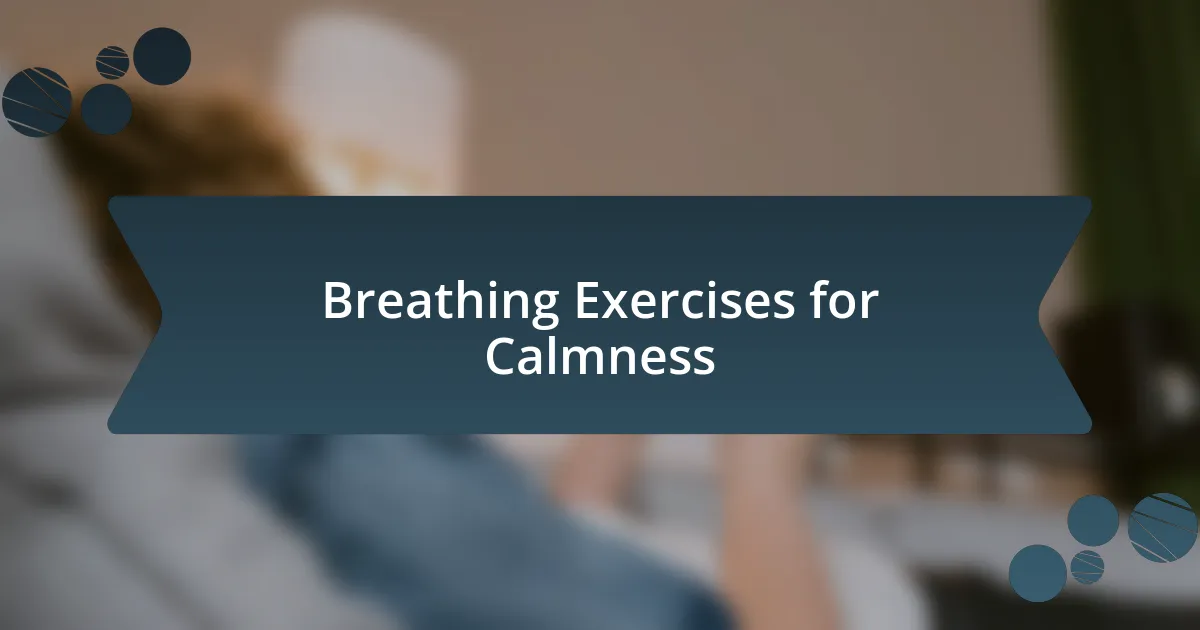
Breathing Exercises for Calmness
Focusing on breath can be a game changer when grappling with pre-tournament anxiety. I vividly remember standing at the start line of a significant competition, heart racing and mind swirling with doubts. In that moment, I took a deep breath in through my nose, held it for a few seconds, and released it slowly through my mouth. It’s amazing how just a few intentional breaths can ground you and clear the mental fog.
One effective breathing exercise I stumbled upon is the ‘4-7-8’ technique. I would inhale deeply for four counts, hold my breath for seven, and then exhale completely for eight counts. The rhythmic pattern seemed to slow down my racing thoughts and foster a sense of calmness. Have you ever tried to just pause and focus solely on your breathing? The tranquility that comes from such a simple act can be incredibly powerful in moments of high stress.
I often found myself using this technique in the days leading up to a tournament. Sitting in a quiet space, I would visualize my performance while practicing these breathing exercises. The combination of controlled breathing and positive visualization created an inner sanctuary of peace, making me feel more centered and prepared. Trust me, taking the time to breathe not only calms the nerves but also enhances my focus, which is crucial when every second counts.


